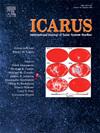High spectral resolution observations of Uranus' near-IR thermospheric H2 emission spectrum using the IGRINS spectrograph during the 2018 and 2023 apparitions
IF 2.5
2区 物理与天体物理
Q2 ASTRONOMY & ASTROPHYSICS
引用次数: 0
Abstract
Ground-based near-IR observations have revealed that Uranus' anomalously hot upper atmosphere, detected by Voyager II, has been steadily cooling. The observed H3+ and H2 emission-line spectra probe Uranus' ionosphere and thermosphere, respectively. Previous observations have shown that the cooling has continued well past the 2007 vernal equinox, when the seasonal solar forcing turned positive, resulting in net heating of the IAU northern hemisphere. Most of them, especially for H2, were obtained at moderate spectral resolution, R ∼ 1000 to 3000, which admits more sky background, with its associated noise, per spectral resolution element relative to spectrographs having higher spectral resolution. We report the first instance of high spectral resolution being used to observe Uranus' fundamental-band rovibrational quadrupole H2 emission spectrum; where the sky background is suppressed and narrow planetary emission lines stand out against the planetary continuum. The IGRINS spectrograph with spectral resolution R ∼ 45,000 was used to observe Uranus in the K-band on Oct 26 & 27, 2018 at the Lowell Discovery Telescope, and on Nov 27, 2023 at Gemini South. These observations reveal rovibrational temperatures of Uranus' thermosphere of 542 ± 25 K and 397 ± 32 K at these two epochs, respectively. The consecutive-nights at elevated temperature observed at the Discovery Telescope suggest that Uranus' near-IR H2 aurora was detected over each of the northern and southern magnetic poles, respectively. The collective IGRINS results support the continued cooling of Uranus' thermosphere through the 2023 apparition, 73 % through the spring season.
2018年和2023年天王星近红外热层H2发射光谱的高光谱分辨率观测
地面近红外观测显示,旅行者2号探测到的天王星异常高温的上层大气一直在稳步冷却。观测到的H3+和H2发射在线光谱分别探测了天王星的电离层和热层。先前的观测表明,降温一直持续到2007年春分之后,当时季节性太阳强迫变为正,导致IAU北半球的净加热。其中大多数,特别是H2,是在中等光谱分辨率下获得的,R ~ 1000 ~ 3000,相对于具有更高光谱分辨率的光谱仪,每个光谱分辨率元素允许更多的天空背景及其相关噪声。我们报告了首次使用高光谱分辨率观测天王星基波段旋转振动四极子H2发射光谱的实例;在那里,天空背景被抑制,狭窄的行星发射线在行星连续体的衬托下突出。10月26日,使用光谱分辨率为R ~ 45,000的IGRINS光谱仪在k波段观测了天王星。2018年11月27日在洛厄尔发现望远镜,以及2023年11月27日在双子座南。这些观测结果显示,在这两个时期,天王星热层的旋转振动温度分别为542±25 K和397±32 K。“发现”望远镜连续几晚观测到的高温表明,天王星的近红外H2极光分别在南北磁极上被探测到。IGRINS的综合结果支持了2023年天王星热层的持续冷却,其中73%是在春季。
本文章由计算机程序翻译,如有差异,请以英文原文为准。
求助全文
约1分钟内获得全文
求助全文
来源期刊

Icarus
地学天文-天文与天体物理
CiteScore
6.30
自引率
18.80%
发文量
356
审稿时长
2-4 weeks
期刊介绍:
Icarus is devoted to the publication of original contributions in the field of Solar System studies. Manuscripts reporting the results of new research - observational, experimental, or theoretical - concerning the astronomy, geology, meteorology, physics, chemistry, biology, and other scientific aspects of our Solar System or extrasolar systems are welcome. The journal generally does not publish papers devoted exclusively to the Sun, the Earth, celestial mechanics, meteoritics, or astrophysics. Icarus does not publish papers that provide "improved" versions of Bode''s law, or other numerical relations, without a sound physical basis. Icarus does not publish meeting announcements or general notices. Reviews, historical papers, and manuscripts describing spacecraft instrumentation may be considered, but only with prior approval of the editor. An entire issue of the journal is occasionally devoted to a single subject, usually arising from a conference on the same topic. The language of publication is English. American or British usage is accepted, but not a mixture of these.
 求助内容:
求助内容: 应助结果提醒方式:
应助结果提醒方式:


